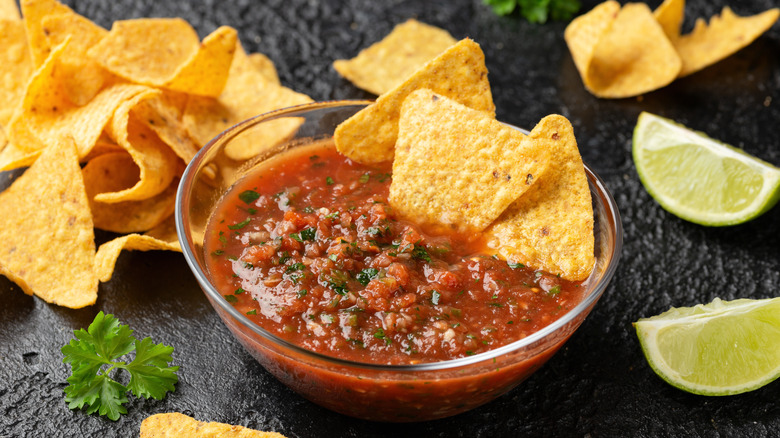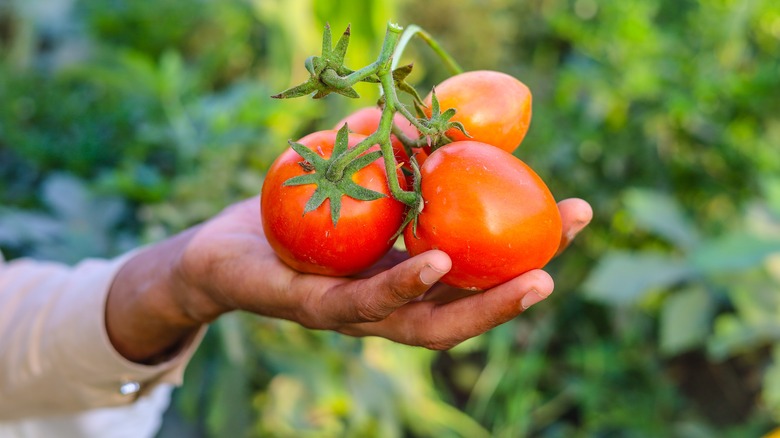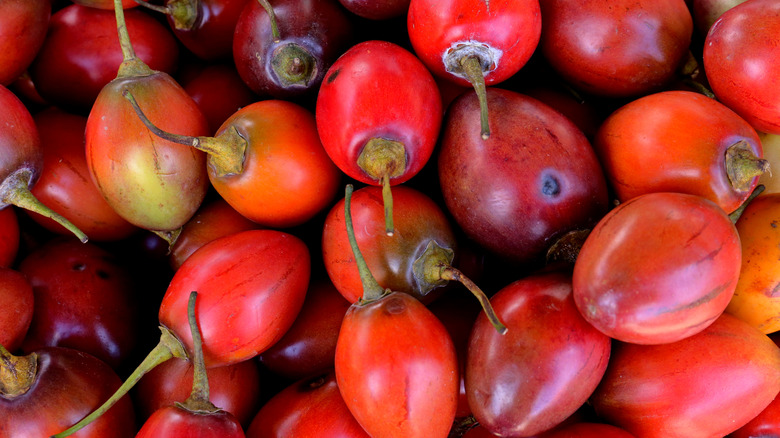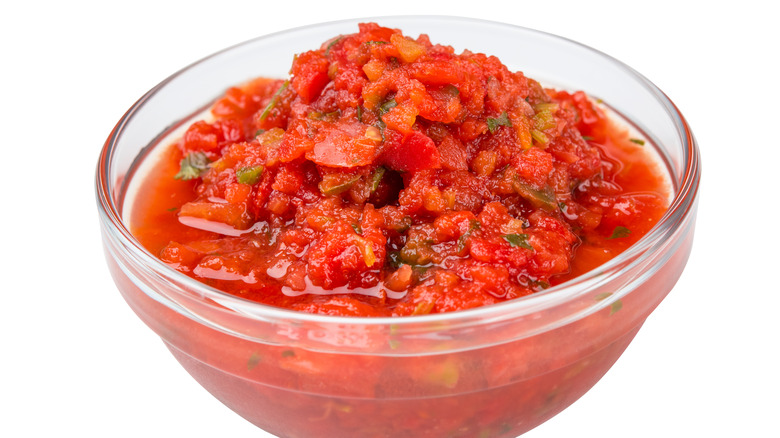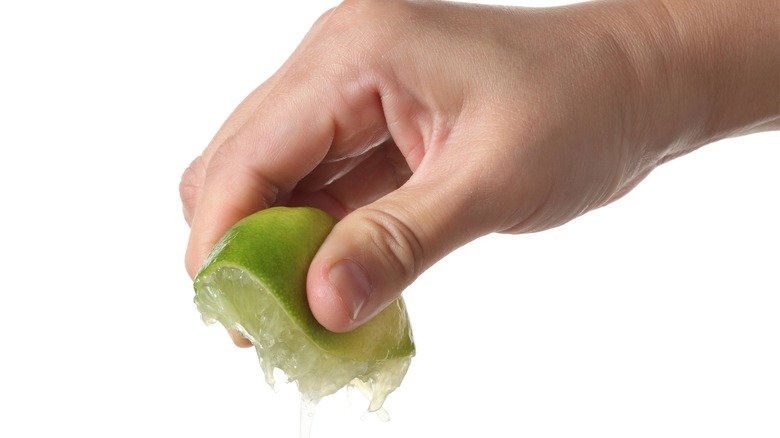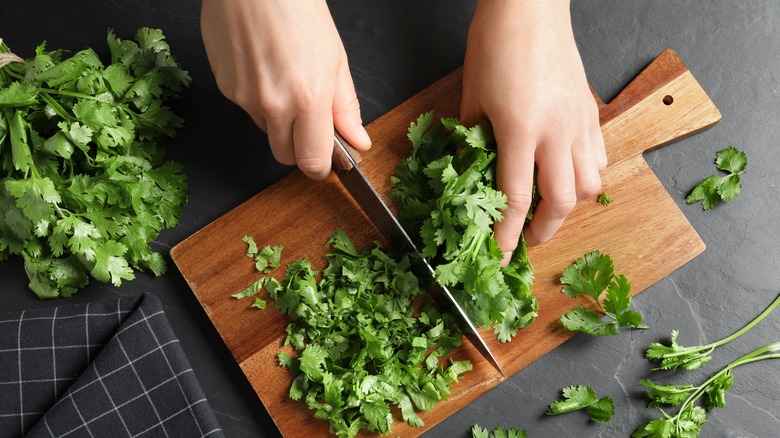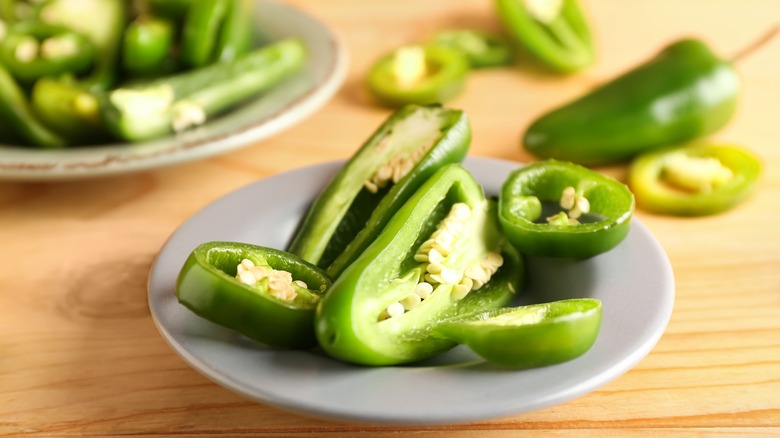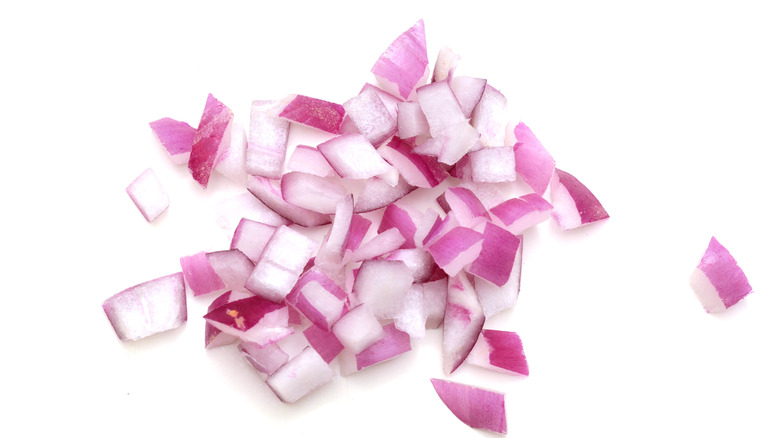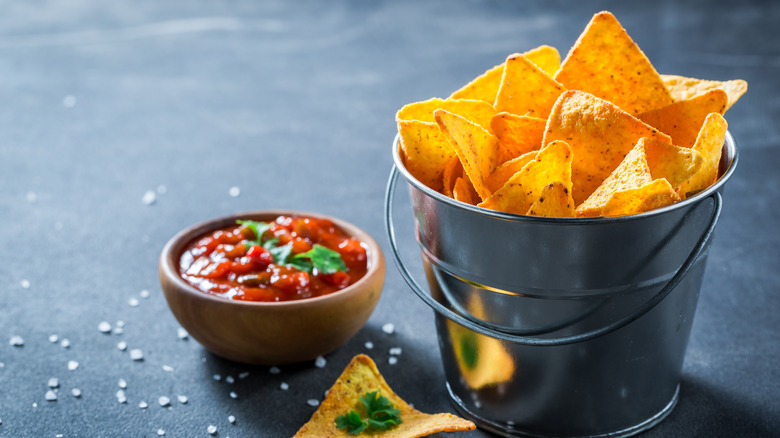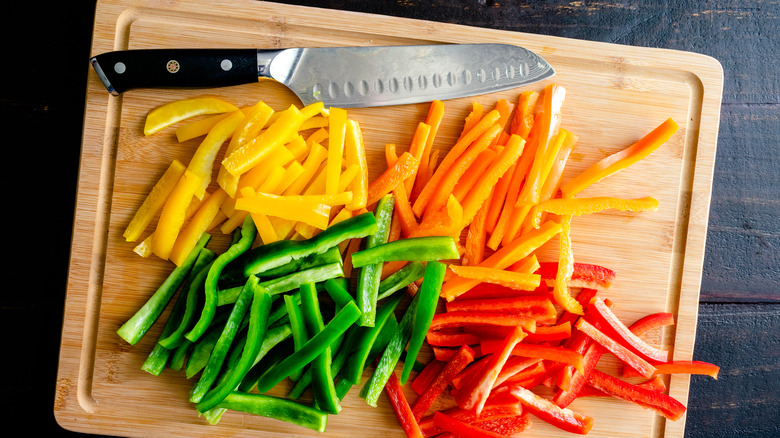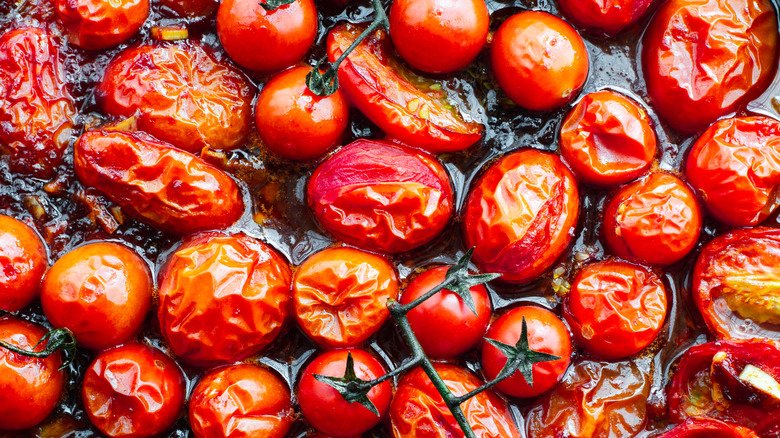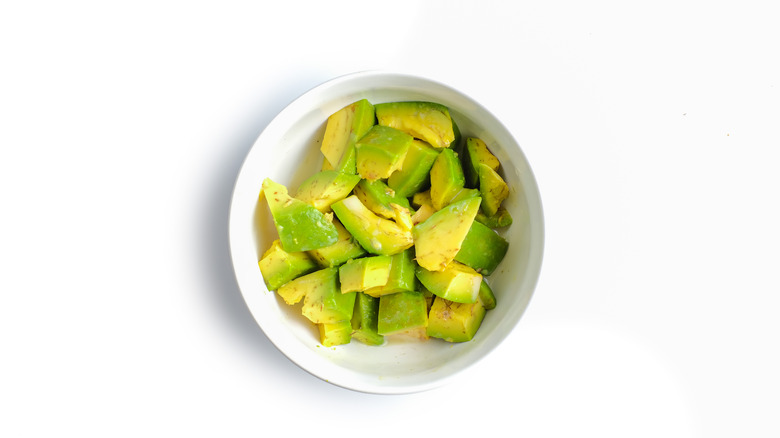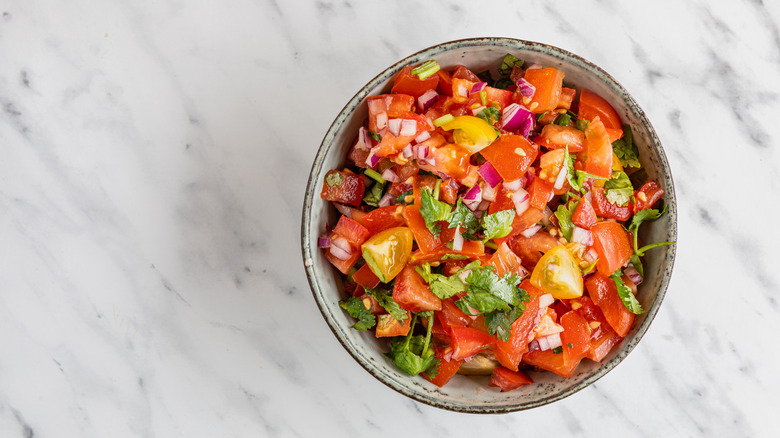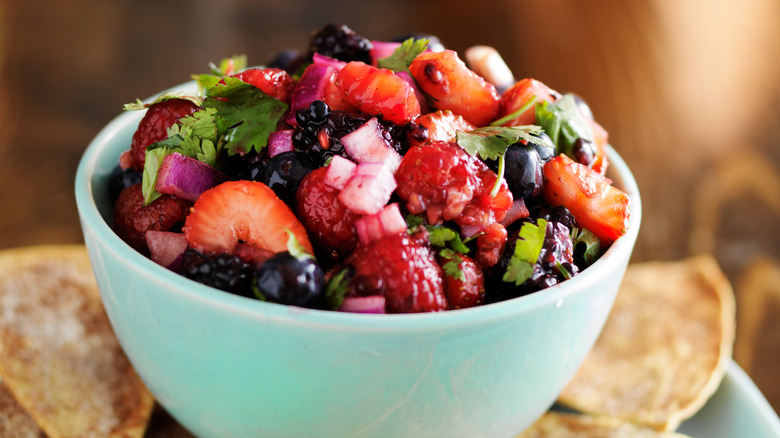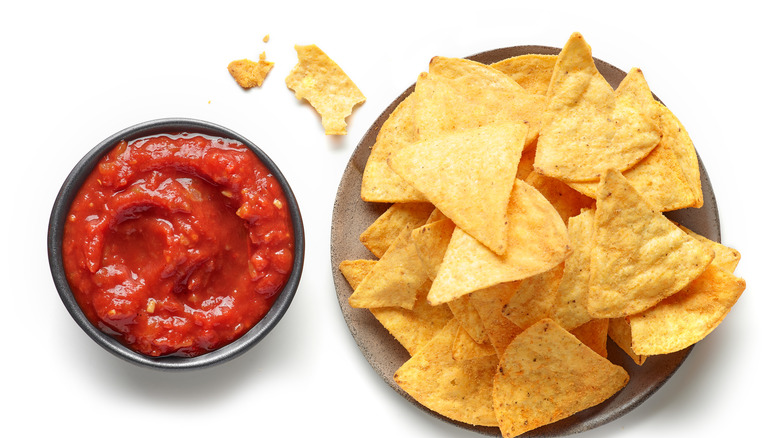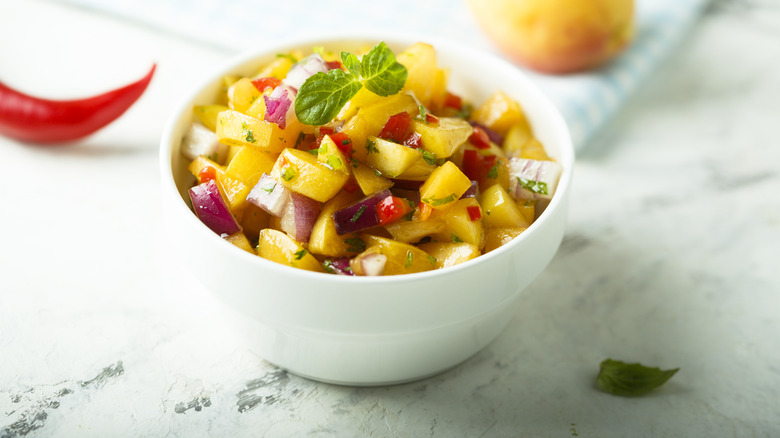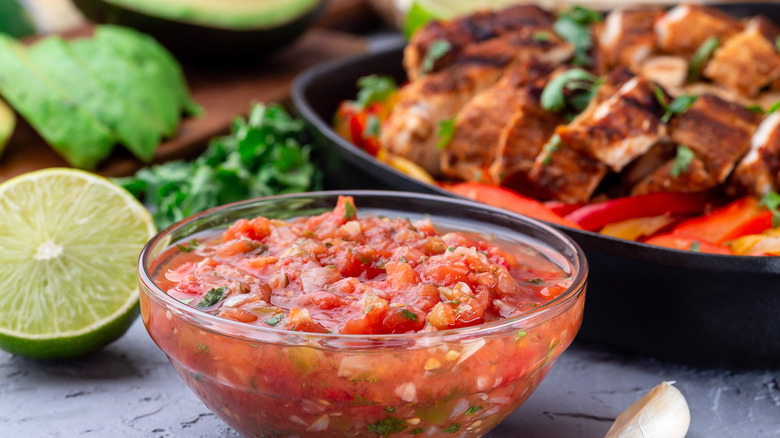17 Ways You're Ruining Homemade Salsa
Is salsa a dip, condiment, or something in between? Regardless of how you enjoy a bowl of salsa, you can probably vouch for its sublime flavor resulting from mashing flavors like salty, sweet, and acidic together in scoop-able form. But what makes salsa, salsa?
The word "salsa" translates to "sauce" in Spanish. In America, "salsa" generally refers to a condiment made with ingredients like tomatoes, onions, an acid, and herbs. However, modern interpretations of salsa include ingredients like avocado, pineapple, and corn. The word "salsa" also includes mole, chimichurri, and sofrito — which are often used to top meat and vegetables after cooking — but for the purpose of this article, we're going to stick to the dip-able salsas, like pico de gallo, salsa fresca, restaurant salsa, and cooked salsa.
Making homemade salsa is relatively simple, but there are some easy ways for home cooks to miss the mark with it. Here are some of the big ones you must avoid the next time you make salsa.
Using the wrong types of tomatoes
Since there are over 10,000 varieties of tomatoes across the globe to choose from, notes North Carolina State University, how do you pick the perfect variety for your salsa? Well, the right tomato depends on what kind of salsa you plan to make. If you're making a chunky salsa, like pico de gallo, you'll want to choose a sturdy tomato that is easy to dice, like any variety in the Beefsteak family. You can also use a Roma tomato for pico de gallo or salsa fresca because it has a low water content with a dense flesh — thus making it easier to prepare than a tomato that would just fall apart in your hands.
If you want to make a salsa roja, otherwise known as a restaurant-style salsa, you should choose a tomato that blends smoothly. Water content and seeds aren't as important since the tomato gets blitzed in a blender or food processor anyway. However, you should try using tomatoes with a fleshy and dense interior like the Roma if you want a super-smooth salsa roja.
Forgetting to seed your tomatos
Seeding the tomato is necessary for salsa fresca or pico de gallo but is considered optional for a salsa roja. Regardless, removing the seeds and the gel-like part of the tomato can help your salsa appear less watery — which is much more appetizing for serving.
The steps for removing the seeds depend on the size of the tomato you're working with. Small tomatoes, like grape and cherry tomato varieties, can be seeded by squeezing them. Cutting and scooping the gel out of these tomatoes is laborious, and squeezing them is much simpler. Squish these tiny tomatoes between your fingers until the seeds and juice pop out of one side and drain into a bowl. The most efficient ways to seed a large tomato include cutting the tomato into quarters and using a paring knife to remove the seeds or cutting the fruit in half using a melon baller or a scoop to remove the inside pocket.
Not letting your salsa rest before serving
If you're making a fresh dip like salsa, you may be inclined to get it on the table as soon as you finish mixing in your last onions. But like all good things in life, salsa needs a bit of time for rest and relaxation. Ideally, you should let your salsa meld together for at least an hour before serving; this will allow an opportunity for the acids and the salt to meld together with the other produce. However, you can also make your salsa the night before you need to serve it for the best possible flavor.
One of the most significant drawbacks to letting your salsa marinate in its juices for too long is that you'll notice a lot of juice weeping from the tomatoes. This is because tomatoes are watery fruits with moisture that gets pulled out when the fruit is exposed to salt. If this happens with your homemade salsa, you can drain the salsa juice or stir it back into the mixture.
Skipping the acid
Acid is undoubtedly one of salsa's best friends. Fresh salsas often feature lime juice as the primary acidic component. However, some recipes call for red wine or distilled white vinegar instead. Avoid using flavored vinegar for your salsa, like apple cider or balsamic, to avoid unsettling flavors. You should also always taste as you make your salsa to avoid adding too much and upsetting the precarious flavor balance.
From a preservation perspective, the acid plays a critical role in helping to extend the shelf life of the salsa. Lemon juice and vinegar are commonly used in salsa canning because of their high acid content. Lemon juice has slightly more acid and a less pronounced flavor than vinegar. You can substitute lemon juice for vinegar in a canned salsa recipe, but you cannot substitute vinegar for lemon juice because it may not be acidic enough to prevent foodborne illness.
Using dried herbs instead of fresh ones
There are some instances when you should be cooking with dried herbs, but making salsa is not one of them. Fresh herbs have a more pronounced kick of flavor and freshness than any dried herb variety. Plus, the short window between making your salsa and serving it won't allow the dried herbs' true potential to shine through.
Some of the most common herbs used in salsa include cilantro and Mexican oregano. You should soak your herbs in ice water before making your sauce to shock back some bright green colors before chopping them up. You only need to submerge your herbs for a few minutes or until the herbs start to perk back up again. It's the perfect trick for the cilantro you left in the back of your refrigerator or the slightly wilted stems you found at your grocery store.
Skipping out on heat
Salsa opens the door to integrating a diversity of flavors into your dish — including spicy ones. One of the most common spicy additions to salsa is jalapeños. Not only will you get the crunch from the outside of the pepper, but you'll also get a sustained sense of heat that will excite your tastebuds. If you don't have access to these peppers, we recommend using jalapeño substitutes like the Fresno pepper or the spicy Serrano.
If heat isn't your thing, we think you should mitigate some of the spice from these peppers by removing the mid-rib and the seeds from the pepper with a paring knife. Since this is where most of the capsaicin is found in the pepper, removing it carefully will still give you the organic taste of the ingredient with much less heat.
Omitting the onions
Onions are almost as crucial of an ingredient in your salsa as tomatoes. They bring a unique sharpness and a bright texture that makes this allium always worth adding to your grocery cart. But how do you decide which onion to use for your salsa?
Our favorite types of onions to use for salsa are red onions and white onions. The flavor is intense enough not to get lost in the sauce but not as sharp as a yellow onion — which would otherwise overpower a humble salsa. White and red onions have a lot of water and a crunchy texture, which is preferable for raw applications. You can also chop up a scallion, otherwise known as a green onion, for a colorful garnish to your salsa, too.
Forgetting to use salt
Salt is undoubtedly an under-appreciated element in the perfect homemade salsa recipe. It can help round out the flavors in raw salsas and highlight the acidic or spicy components you use in your recipe. You can use whatever type of salt you like in your recipe, including iodized salt, because it will not produce a different taste than other types of salt, like kosher salt or sea salt.
If you plan to can your salsa, you can use whatever type of salt you prefer. Canning salsa is one of the most common types to use for everything from pickles to marinades, but it is harder to find in stores. Using iodized salt instead of canning salt may produce metallic or bitter notes and make your salsa cloudy. This is because iodized salt typically contains anti-caking agents, which canning salt does not.
Only using one type of pepper
Peppers are a colorful ingredient that can keep your salsa recipe exciting. You should use a blend of peppers in your fresh salsa recipe to enhance the flavors and textures you get in each bite. For example, you can play with the flavors of a smoky ancho with a bright, spicy serrano. Pasilla peppers lean more to the fruity and floral side of things, while the guajillo has a mild smokiness that is best amplified with the ancho.
Some peppers pair better with different ingredients, too. The criolla sella has a citrusy and mango flavor that can easily amplify the taste of a fruity salsa. The habanero has notes of coconut and papaya that pair well with those respective fruits or can contrast with a smokey, darker salsa roja.
Not roasting your tomatoes
Fire-roasting your tomatoes will add a delectable layer of char to your tomatoes before you add them to your salsa. It's also an easy way to peel tomatoes when making homemade salsa. Start by placing the tomatoes (or chilis and tomatillos, if you want char all-around) in a cast iron pan, barbecue grill, or gas stove grill. Wait a few minutes until the tomatoes blister before moving the fruit around to char every side.
If you want to get the same flavor of fire-roasted salsa, just without roasting the tomatoes yourself, you can use canned tomatoes. Our fire-roasted salsa recipe uses two cans of fire-roasted tomatoes, lime, garlic, jalapeño, and salt together in a blender. It can't get any easier than that.
Omitting a fat
If you add too much of a good thing — acid, heat, or sweet — you can always bring things around by adding a fatty ingredient. For example, adding some chunks of avocado to your salsa can mild out the flavors and provide somewhat of a palate cleanse to each bite. One unconventional ingredient that will change your salsa forever is peanut butter. Adding this creamy, fatty flavor can help mellow out some of the heat from the peppers. If you're skeptical, just remember what peanut butter does for Pad Thai.
If you include this spread in your salsa, you'll want to purée it with other standard ingredients like Serranos, garlic, oil, and onion. This tomato-less salsa is perfect for topping tofu scrambles and tacos or as a dip served with your favorite tortilla chips.
Forgetting a sweet element
It can be tough not to go overboard with your salsa's hot and spicy elements. But there is a time and a place for everything — including a little bit of sweetness. The game-changing ingredient you should add to fire-roasted salsa (or any salsa) is honey. It maintains the same organic flair as the rest of your salsa but can also help tame some of the other contrasting flavors in your dish. If you want more heat with your sweet, we recommend using hot honey instead of plain.
If you can't eat honey, agave nectar is the second-best option to add to your homemade salsa. The one thing to remember about this alternative sweetener is that it is significantly sweeter than table sugar — meaning that a few too many drops can make your salsa too sweet.
Making the same type of salsa every time
We think that making the same salsa recipe repeatedly gets boring. Luckily, many ways to spice up your salsa recipe integrate different preparation methods and styles. Some of the more unconventional types of salsa include salsa bruja — a hot pickled vegetable salsa made with chiles, onion, garlic, oil, vinegar, and vegetables like cactus paddles or carrots. Its most common pairings include seafood, but you might also see it paired with tacos and chilaquiles.
If you can't decide if you want guacamole or salsa, you should try making avocado salsa (otherwise known as salsa de aguacate). This salsa has similar ingredients to a salsa verde — just with avocado blended in. Since the avocado oxidizes quickly, eating salsa de aguacate relatively soon after preparing is best.
Remaining in the confines of savory salsa
Anything can be a salsa if you try hard enough. That's why we love taking salsa to a new level using only sweet ingredients. For example, you can make berry salsa by chopping up blackberries, strawberries, blueberries, and fresh basil. Macerate the fruit with some sugar and a spritz of lemon juice, and your salsa is ready. We recommend spooning it onto your morning plate of waffles or pancakes, on top of a yogurt parfait, or as a dip with cinnamon-sugar tortilla chips.
You can also transform deconstructed desserts into salsa. Strawberry rhubarb pie is a classic fruity combination that can be easily made into a salsa by combining sliced berries, rhubarb stalks, red onion, honey, and olive oil. It's a great accompaniment to fish and a side for snacking. If you love the fall flavors of apples, you can make a salsa with cinnamon-baked apples, raisins, and chopped nuts served with graham crackers or pita chips.
Serving your salsa with the wrong kind of chip
There's no more iconic pairing in the food world than chips and salsa. But getting the right kind of tortilla chip is essential because it has to carry the weight of a great homemade salsa. The perfect tortilla chip for us is sturdy and not overly salty. To get this idyllic chip, you'll want to go the extra step of making tortilla chips at home.
Start by quartering corn tortillas. We've found that tortillas that are left out overnight or even for a few hours tend to crisp up faster than those coming straight from the bag. Shallow-fry the chips at 350 degrees Fahrenheit for about two to three minutes. The chips should be crispy and slightly browned and no longer bubble on the sides. Then, transfer to a lined sheet and immediately sprinkle with salt (or cinnamon sugar if you're making sweet chips).
Not trying to add fruit to your salsa
Fruit is the unsung hero that your salsa needs. Adding a little bit of chopped pineapple or mango to your salsa can help brighten the flavor and provide a sweet element that diminishes the need to add an additional sweetener like honey. Another unconventional fruit you need to try in your next batch of salsa is cape gooseberries. These fruits are similar in texture and relatedness to a tomatillo, making them the perfect addition to salsa. However, unlike the gooseberry in the currant family, the cape gooseberry has the thin papery husk of a tomatillo with a beautiful orange hue. You should only eat these fruits after they have fully ripened; the husk on a ripe fruit will be pale in color or fall off.
The cape gooseberry's qualities allow it to be used like a tomatillo. You can chop the ripe ones up and add directly to the salsa or fire-roast them for an added char.
Serving salsa cold
It's common to pull a jar of salsa from the fridge, spoon it into a cup, and dip your chips in straight away. But for the best flavor from your salsa, you should try to warm it up to room temperature first. This will help bring out the taste of the tomatoes more; it's why salsa is often served warm in terra cotta pots in salsa's origin country of Mexico.
If you're too impatient to wait for your salsa to warm up to room temperature, you can always resort to more technical methods. You can place the salsa in a microwave-safe dish and heat it for 30-second intervals until it's warm to the touch but not hot. Remember to stir at regular intervals to prevent uneven heating. Next, you can add the salsa with a bit of water to a frying pan and heat it until warm.
